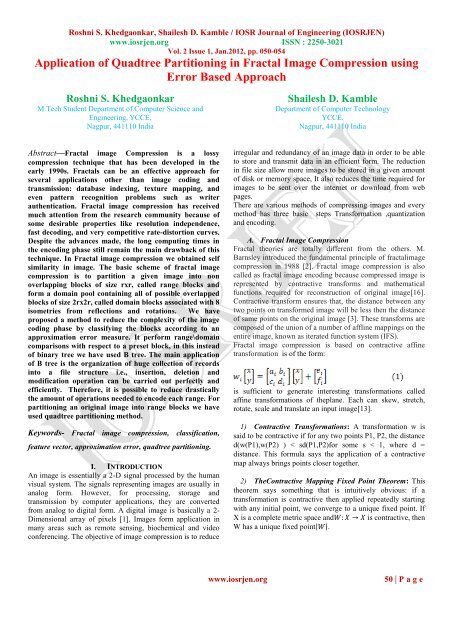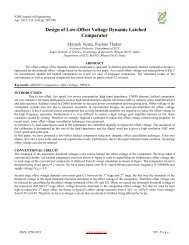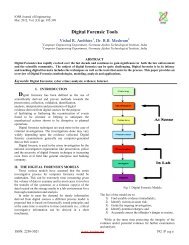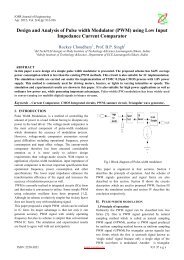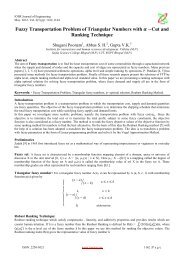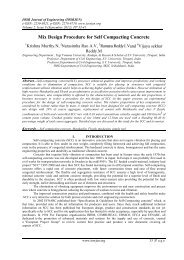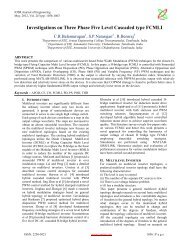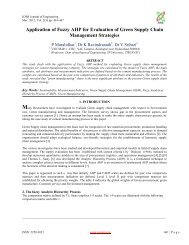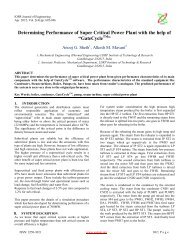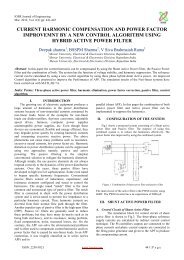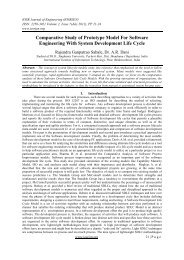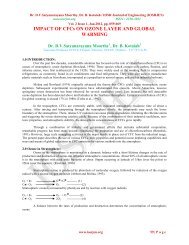Application of Quadtree Partitioning in Fractal Image ... - IOSRJEN
Application of Quadtree Partitioning in Fractal Image ... - IOSRJEN
Application of Quadtree Partitioning in Fractal Image ... - IOSRJEN
You also want an ePaper? Increase the reach of your titles
YUMPU automatically turns print PDFs into web optimized ePapers that Google loves.
Roshni S. Khedgaonkar, Shailesh D. Kamble / IOSR Journal <strong>of</strong> Eng<strong>in</strong>eer<strong>in</strong>g (<strong>IOSRJEN</strong>)<br />
www.iosrjen.org ISSN : 2250-3021<br />
Vol. 2 Issue 1, Jan.2012, pp. 050-054<br />
<strong>Application</strong> <strong>of</strong> <strong>Quadtree</strong> <strong>Partition<strong>in</strong>g</strong> <strong>in</strong> <strong>Fractal</strong> <strong>Image</strong> Compression us<strong>in</strong>g<br />
Error Based Approach<br />
Roshni S. Khedgaonkar<br />
M.Tech Student Department <strong>of</strong> Computer Science and<br />
Eng<strong>in</strong>eer<strong>in</strong>g, YCCE,<br />
Nagpur, 441110 India<br />
Shailesh D. Kamble<br />
Department <strong>of</strong> Computer Technology<br />
YCCE,<br />
Nagpur, 441110 India<br />
Abstract—<strong>Fractal</strong> image Compression is a lossy<br />
compression technique that has been developed <strong>in</strong> the<br />
early 1990s. <strong>Fractal</strong>s can be an effective approach for<br />
several applications other than image cod<strong>in</strong>g and<br />
transmission: database <strong>in</strong>dex<strong>in</strong>g, texture mapp<strong>in</strong>g, and<br />
even pattern recognition problems such as writer<br />
authentication. <strong>Fractal</strong> image compression has received<br />
much attention from the research community because <strong>of</strong><br />
some desirable properties like resolution <strong>in</strong>dependence,<br />
fast decod<strong>in</strong>g, and very competitive rate-distortion curves.<br />
Despite the advances made, the long comput<strong>in</strong>g times <strong>in</strong><br />
the encod<strong>in</strong>g phase still rema<strong>in</strong> the ma<strong>in</strong> drawback <strong>of</strong> this<br />
technique. In <strong>Fractal</strong> image compression we obta<strong>in</strong>ed self<br />
similarity <strong>in</strong> image. The basic scheme <strong>of</strong> fractal image<br />
compression is to partition a given image <strong>in</strong>to non<br />
overlapp<strong>in</strong>g blocks <strong>of</strong> size rxr, called range blocks and<br />
form a doma<strong>in</strong> pool conta<strong>in</strong><strong>in</strong>g all <strong>of</strong> possible overlapped<br />
blocks <strong>of</strong> size 2rx2r, called doma<strong>in</strong> blocks associated with 8<br />
isometries from reflections and rotations. We have<br />
proposed a method to reduce the complexity <strong>of</strong> the image<br />
cod<strong>in</strong>g phase by classify<strong>in</strong>g the blocks accord<strong>in</strong>g to an<br />
approximation error measure. It perform range\doma<strong>in</strong><br />
comparisons with respect to a preset block, <strong>in</strong> this <strong>in</strong>stead<br />
<strong>of</strong> b<strong>in</strong>ary tree we have used B tree. The ma<strong>in</strong> application<br />
<strong>of</strong> B tree is the organization <strong>of</strong> huge collection <strong>of</strong> records<br />
<strong>in</strong>to a file structure i.e., <strong>in</strong>sertion, deletion and<br />
modification operation can be carried out perfectly and<br />
efficiently. Therefore, it is possible to reduce drastically<br />
the amount <strong>of</strong> operations needed to encode each range. For<br />
partition<strong>in</strong>g an orig<strong>in</strong>al image <strong>in</strong>to range blocks we have<br />
used quadtree partition<strong>in</strong>g method.<br />
Keywords- <strong>Fractal</strong> image compression, classification,<br />
feature vector, approximation error, quadtree partition<strong>in</strong>g.<br />
I. INTRODUCTION<br />
An image is essentially a 2-D signal processed by the human<br />
visual system. The signals represent<strong>in</strong>g images are usually <strong>in</strong><br />
analog form. However, for process<strong>in</strong>g, storage and<br />
transmission by computer applications, they are converted<br />
from analog to digital form. A digital image is basically a 2-<br />
Dimensional array <strong>of</strong> pixels [1]. <strong>Image</strong>s form application <strong>in</strong><br />
many areas such as remote sens<strong>in</strong>g, biochemical and video<br />
conferenc<strong>in</strong>g. The objective <strong>of</strong> image compression is to reduce<br />
irregular and redundancy <strong>of</strong> an image data <strong>in</strong> order to be able<br />
to store and transmit data <strong>in</strong> an efficient form. The reduction<br />
<strong>in</strong> file size allow more images to be stored <strong>in</strong> a given amount<br />
<strong>of</strong> disk or memory space, It also reduces the time required for<br />
images to be sent over the <strong>in</strong>ternet or download from web<br />
pages.<br />
There are various methods <strong>of</strong> compress<strong>in</strong>g images and every<br />
method has three basic steps Transformation ,quantization<br />
and encod<strong>in</strong>g.<br />
A. <strong>Fractal</strong> <strong>Image</strong> Compression<br />
<strong>Fractal</strong> theories are totally different from the others. M.<br />
Barnsley <strong>in</strong>troduced the fundamental pr<strong>in</strong>ciple <strong>of</strong> fractalimage<br />
compression <strong>in</strong> 1988 [2]. <strong>Fractal</strong> image compression is also<br />
called as fractal image encod<strong>in</strong>g because compressed image is<br />
represented by contractive transforms and mathematical<br />
functions required for reconstruction <strong>of</strong> orig<strong>in</strong>al image[16].<br />
Contractive transform ensures that, the distance between any<br />
two po<strong>in</strong>ts on transformed image will be less then the distance<br />
<strong>of</strong> same po<strong>in</strong>ts on the orig<strong>in</strong>al image [3]. These transforms are<br />
composed <strong>of</strong> the union <strong>of</strong> a number <strong>of</strong> affl<strong>in</strong>e mapp<strong>in</strong>gs on the<br />
entire image, known as iterated function system (IFS).<br />
<strong>Fractal</strong> image compression is based on contractive aff<strong>in</strong>e<br />
transformation is <strong>of</strong> the form:<br />
is sufficient to generate <strong>in</strong>terest<strong>in</strong>g transformations called<br />
aff<strong>in</strong>e transformations <strong>of</strong> theplane. Each can skew, stretch,<br />
rotate, scale and translate an <strong>in</strong>put image[13].<br />
1) Contractive Transformations: A transformation w is<br />
said to be contractive if for any two po<strong>in</strong>ts P1, P2, the distance<br />
d(w(P1),w(P2) ) < sd(P1,P2)for some s < 1, where d =<br />
distance. This formula says the application <strong>of</strong> a contractive<br />
map always br<strong>in</strong>gs po<strong>in</strong>ts closer together.<br />
2) TheContractive Mapp<strong>in</strong>g Fixed Po<strong>in</strong>t Theorem: This<br />
theorem says someth<strong>in</strong>g that is <strong>in</strong>tuitively obvious: if a<br />
transformation is contractive then applied repeatedly start<strong>in</strong>g<br />
with any <strong>in</strong>itial po<strong>in</strong>t, we converge to a unique fixed po<strong>in</strong>t. If<br />
X is a complete metric space andW: X → X is contractive, then<br />
W has a unique fixed po<strong>in</strong>t W .<br />
www.iosrjen.org<br />
50 | P a g e
Roshni S. Khedgaonkar, Shailesh D. Kamble / IOSR Journal <strong>of</strong> Eng<strong>in</strong>eer<strong>in</strong>g (<strong>IOSRJEN</strong>)<br />
www.iosrjen.org ISSN : 2250-3021<br />
Vol. 2 Issue 1, Jan.2012, pp. 050-054<br />
3) <strong>Fractal</strong> Encod<strong>in</strong>g : <strong>Fractal</strong> image Compression is a<br />
lossy compression technique that has been developed <strong>in</strong> the<br />
early 1990s. fractal image compression is based on partition a<br />
given image <strong>in</strong>to non overlapp<strong>in</strong>g blocks <strong>of</strong> size rxr, called<br />
range blocks and form a doma<strong>in</strong> pool conta<strong>in</strong><strong>in</strong>g all <strong>of</strong><br />
possible overlapped blocks <strong>of</strong> size 2rx2r, called doma<strong>in</strong> blocks<br />
associated with 8 isometries from reflections and rotations [4].<br />
For each range block, it exhaustively searches, the doma<strong>in</strong><br />
pool, for a best-matched doma<strong>in</strong> block with the m<strong>in</strong>imum rms<br />
error after apply<strong>in</strong>g a contractive aff<strong>in</strong>e transform to the<br />
doma<strong>in</strong> block. The problems that occur <strong>in</strong> fractal encod<strong>in</strong>g are<br />
the computational demands and the existence <strong>of</strong> best rangedoma<strong>in</strong><br />
matches [5]. However search<strong>in</strong>g the doma<strong>in</strong> pool is<br />
highly computationally <strong>in</strong>tensive. For an nxn image, the<br />
number <strong>of</strong> range blocks are (nxn/rxr) and the number <strong>of</strong><br />
doma<strong>in</strong> blocks are (n-2r+1) x (n-2r+1). The computation <strong>of</strong><br />
best match between a range block and a doma<strong>in</strong> block is O<br />
(r2). If r is constant, the computation complexity <strong>of</strong> entire<br />
search is O (n4) [15].<br />
A.E. Jacqu<strong>in</strong> gave first publication on <strong>Fractal</strong> image<br />
compression with partitioned IFS (PIFS) <strong>in</strong> 1990 [6], [7], [8].<br />
In Jacqu<strong>in</strong>‟s method the image is partitioned <strong>in</strong> sub images<br />
called as „Range blocks‟ and PIFS are applied on sub-images,<br />
rather than the entire image [17]. Locat<strong>in</strong>g the range blocks on<br />
their respective position <strong>in</strong> image itself forms the entire image.<br />
Temporary images used to form range blocks are known as<br />
doma<strong>in</strong> blocks.<br />
The overall process <strong>of</strong> fractal image encod<strong>in</strong>g <strong>in</strong>cludes four<br />
levels <strong>of</strong> decision mak<strong>in</strong>g the flow is shown <strong>in</strong> the Figure 1.<br />
In any <strong>Fractal</strong> compression system the first decision is to<br />
choose the type <strong>of</strong> image partition for the design <strong>of</strong> range<br />
blocks. A wide variety <strong>of</strong> partitions have been <strong>in</strong>vestigated but<br />
we have used quad tree partition<strong>in</strong>g[18],[20],[21].Our partition<br />
method is based on a split/merge approach as <strong>in</strong>troduced by<br />
Horowitz and Pavlidis <strong>in</strong> [19]. Doma<strong>in</strong> pool is the second<br />
level <strong>of</strong> decision. This choice depends on the type <strong>of</strong> partition<br />
scheme used. In third step we form a class <strong>of</strong> transform<br />
applied to the doma<strong>in</strong> block and <strong>in</strong> the f<strong>in</strong>al step search<strong>in</strong>g<br />
most suitable doma<strong>in</strong> block for the formation <strong>of</strong> particular<br />
range block. This step <strong>of</strong> fractal image compression is<br />
computationally very expensive, because it requires a large<br />
number <strong>of</strong> doma<strong>in</strong> range comparisons. The attempts to<br />
improve encod<strong>in</strong>g speed are addressed as speed-up techniques<br />
and focused on two areas such as doma<strong>in</strong> classification based<br />
methods and feature vector based methods.<br />
At present, fractal cod<strong>in</strong>g cannot compete with other<br />
techniques (wavelets, etc.) if compression per se is <strong>in</strong>volved.<br />
However, most <strong>of</strong> the <strong>in</strong>terest <strong>in</strong> fractal cod<strong>in</strong>g is due to its<br />
side applications <strong>in</strong> fields such as image database <strong>in</strong>dex<strong>in</strong>g [9]<br />
and face recognition [10]. So, our ma<strong>in</strong> aim is to short the<br />
encod<strong>in</strong>g time, speed-up the cod<strong>in</strong>g phase <strong>of</strong> fractal image<br />
compression and to reduce the computational cost <strong>of</strong><br />
exhaustive search while still preserv<strong>in</strong>g a good image quality,<br />
we will apply classification method for fractal image<br />
compression called DRDC based on an approximation error<br />
Partition an image us<strong>in</strong>g Quad tree<br />
<strong>Partition<strong>in</strong>g</strong><br />
Selection <strong>of</strong> doma<strong>in</strong> pool<br />
Selection <strong>of</strong> Transform<br />
Suitable Doma<strong>in</strong> search<br />
Figure 1. Decision mak<strong>in</strong>g levels <strong>in</strong> fractal encod<strong>in</strong>g[14].<br />
measure. Which will used to perform range/doma<strong>in</strong><br />
comparisons with respect to a preset block, a preset block is<br />
used as a temporary replacement.<br />
The cod<strong>in</strong>g process <strong>of</strong> DRDC is divided <strong>in</strong> two phases. In the<br />
first phase, where the doma<strong>in</strong> codebook is created, all the<br />
doma<strong>in</strong>s are extracted from the image, then each <strong>of</strong> them is<br />
compared with the preset block by solv<strong>in</strong>g a mean square root<br />
problem. The preset block/doma<strong>in</strong> approximation error is<br />
computed and stored <strong>in</strong> a B tree data structure. The ma<strong>in</strong><br />
application <strong>of</strong> B tree is the organization <strong>of</strong> huge collection <strong>of</strong><br />
records <strong>in</strong>to a file structure. The organization should be <strong>in</strong><br />
such a way that any record <strong>in</strong> it can be searched very<br />
efficiently i.e., <strong>in</strong>sertion, deletion and modification operation<br />
can be carried out perfectly and efficiently. In this paper, we<br />
are extend<strong>in</strong>g the work <strong>of</strong> R. Distasi <strong>in</strong> [11] they have used<br />
doma<strong>in</strong> tree for <strong>in</strong>sertion, selection and nearest neighbor<br />
search operation where as we are us<strong>in</strong>g B tree for perform<strong>in</strong>g<br />
the same operation because B tree is an efficient technique, it<br />
guarantees at least 50% storage utilization and it gives good<br />
performance as compare to Doma<strong>in</strong> tree as a b<strong>in</strong>ary tree.<br />
In the second phase, the ranges have to be encoded; each one<br />
<strong>of</strong> them is compared with the preset block, thus obta<strong>in</strong><strong>in</strong>g the<br />
preset block/range approximation error, <strong>in</strong> the same way as we<br />
did for doma<strong>in</strong>s. Us<strong>in</strong>g this data, we f<strong>in</strong>d the doma<strong>in</strong>s that are<br />
likely to encode the current range with the best accuracy. This<br />
criterion is formally justified by the lemma <strong>in</strong> Section II <strong>in</strong><br />
[11] which proves that a generic range block is accurately<br />
coded by doma<strong>in</strong>s with equal or similar approximation error.<br />
In this way, for each range we have to perform a much smaller<br />
www.iosrjen.org<br />
51 | P a g e
Roshni S. Khedgaonkar, Shailesh D. Kamble / IOSR Journal <strong>of</strong> Eng<strong>in</strong>eer<strong>in</strong>g (<strong>IOSRJEN</strong>)<br />
www.iosrjen.org ISSN : 2250-3021<br />
Vol. 2 Issue 1, Jan.2012, pp. 050-054<br />
number <strong>of</strong> range/doma<strong>in</strong> comparisons, and the time spent for<br />
cod<strong>in</strong>g is significantly reduced.<br />
The paper is organized as follows: In Section II, we present<br />
the DRDC strategy and quadtree partition<strong>in</strong>g method, while<br />
Section III illustrates the experimental setup and results.<br />
F<strong>in</strong>ally, Section IV gives conclusion.<br />
II. PROPOSED APPROACH<br />
In case <strong>of</strong> fractal cod<strong>in</strong>g, we have to reduce the search time,<br />
because full exhaustive search is prohibitively costly. Many<br />
different solutions have been proposed for this problem. For<br />
<strong>in</strong>stance, modify<strong>in</strong>g the partition<strong>in</strong>g process or provid<strong>in</strong>g new<br />
classification criteria or heuristic methods for the<br />
range/doma<strong>in</strong> match<strong>in</strong>g problem. All these approaches can be<br />
grouped <strong>in</strong> two classes[12]:<br />
Classification methods and<br />
Feature vectors.<br />
The fundamental idea <strong>of</strong> this algorithm consists <strong>in</strong> deferr<strong>in</strong>g<br />
the comparisons between ranges and doma<strong>in</strong>s, utiliz<strong>in</strong>g a<br />
preset block d , as a temporary replacement with which ranges<br />
and doma<strong>in</strong>s are compared.<br />
After comput<strong>in</strong>g the preset block as the average block.<br />
d = 1 R<br />
r∈R<br />
r<br />
given <strong>in</strong> Algorithm1. This process is repeated iteratively until<br />
each block meets the criterion. The result may have blocks <strong>of</strong><br />
several different sizes. THRESHOLD is specified as a value<br />
between 0 and 1.<br />
Doma<strong>in</strong><br />
Tree<br />
---<br />
--<br />
Doma<strong>in</strong><br />
codebook<br />
extracted<br />
from <strong>in</strong>put<br />
<strong>Image</strong><br />
Comparison<br />
with the<br />
middle block<br />
and feature<br />
vectors<br />
extraction<br />
Insert<strong>in</strong>g the<br />
feature vector<br />
<strong>in</strong> the<br />
Doma<strong>in</strong> tree.<br />
In the first phase, all doma<strong>in</strong>s are compared with d , and the<br />
approximation error is computed and stored <strong>in</strong> a KD-tree or<br />
Doma<strong>in</strong> tree, as shown <strong>in</strong> Figure 2. Doma<strong>in</strong> tree is a b<strong>in</strong>ary<br />
tree, <strong>in</strong> which every node consists <strong>of</strong> two references, one to the<br />
left child and one to the right. Insertion, search and nearestneighbor<br />
search operations are def<strong>in</strong>ed on it. The doma<strong>in</strong> tree<br />
is structured so that every bit <strong>of</strong> the feature vector corresponds<br />
to one tree level, from the most significant <strong>in</strong> the root to the<br />
least mean<strong>in</strong>gful one <strong>in</strong> the leaves.<br />
Figure2.First Phase <strong>of</strong> DRDC Process<br />
In the second phase, all ranges to be encoded are compared<br />
withd and the approximation error is computed but not stored:<br />
It is used as a feature vector and serves as the search key for<br />
locat<strong>in</strong>g the best fitt<strong>in</strong>g doma<strong>in</strong> for the given range. This is<br />
illustrated <strong>in</strong> Figure3.<br />
To see how it is done, consider a function ψ ∶ R n × R n →<br />
R n , where n = r = d , andd represents the doma<strong>in</strong> after<br />
contraction, as def<strong>in</strong>ed <strong>in</strong>[11].<br />
In this paper, we have captured the colour image, convert it<br />
<strong>in</strong>to gray scale image and partition that image us<strong>in</strong>g <strong>Quadtree</strong><br />
partition<strong>in</strong>g method. The basic process <strong>of</strong> quadtree<br />
partition<strong>in</strong>g is shown <strong>in</strong> Figure 4. In quadtree the orig<strong>in</strong>al<br />
image blocks are split <strong>in</strong>to four different quadrant and the<br />
concept <strong>of</strong> threshold is used <strong>in</strong> which splits a block if the<br />
maximum value <strong>of</strong> the block elements m<strong>in</strong>us the m<strong>in</strong>imum<br />
value <strong>of</strong> the block elements is greater than THRESHOLD as<br />
www.iosrjen.org<br />
52 | P a g e
Roshni S. Khedgaonkar, Shailesh D. Kamble / IOSR Journal <strong>of</strong> Eng<strong>in</strong>eer<strong>in</strong>g (<strong>IOSRJEN</strong>)<br />
www.iosrjen.org ISSN : 2250-3021<br />
Vol. 2 Issue 1, Jan.2012, pp. 050-054<br />
Range that have<br />
to be encoded<br />
by the DRDC<br />
algorithm<br />
Comparison<br />
with the middle<br />
block and<br />
feature vectors<br />
extraction<br />
Resiz<strong>in</strong>g an image <strong>in</strong> standard size nxn;<br />
if(max Bi − m<strong>in</strong> Bi ) > θ) then<br />
Split <strong>in</strong>to Bi, i=1,…4;<br />
fori=1,. . . ,4 do<br />
Bi =Split(Bi)<br />
end for<br />
end if<br />
return Block B<br />
Doma<strong>in</strong><br />
Tree<br />
The range ri is encoded<br />
with the doma<strong>in</strong> dj<br />
Search<strong>in</strong>g for<br />
the best fitt<strong>in</strong>g<br />
doma<strong>in</strong> <strong>in</strong> the<br />
Doma<strong>in</strong> tree<br />
III. EXPERIMENTALSETUP AND RESULTS<br />
In order to reduce the encod<strong>in</strong>g time, we have tested the first<br />
module <strong>of</strong> our approach on the Lena colour image <strong>of</strong> size<br />
225x225 and then converted <strong>in</strong>to the greyscale image <strong>of</strong><br />
standard size namely- 512x512. We have partition the orig<strong>in</strong>al<br />
image <strong>in</strong> 16x16, 8x8, and 4x4 pixel blocks us<strong>in</strong>g a quadtree<br />
partition<strong>in</strong>gwith THRESHOLD value as 0.27. The quad tree<br />
partition<strong>in</strong>g <strong>of</strong> lena image is shown <strong>in</strong> Figure5.<br />
Experimentation has been performed us<strong>in</strong>g MATLAB 7.9<br />
development tool on WINDOWS platform. Hardware<br />
requirement <strong>of</strong> proposed approach is general m<strong>in</strong>imum<br />
configuration, Pentium III Processor and 256MB RAM.<br />
Figure3.Second Phase <strong>of</strong> DRDC Process<br />
IV. CONCLUSIONS<br />
In this paper, we have adopted classification method for<br />
fractal image compression called DRDC. It is based on the<br />
1<br />
2<br />
3<br />
4<br />
(a)<br />
(b)<br />
b))<br />
(c)<br />
(a)<br />
(d)<br />
Figure4.Quad tree partition<strong>in</strong>g process: (a) Orig<strong>in</strong>al Block (b) Orig<strong>in</strong>al block<br />
partitioned <strong>in</strong>to four different quadrant (c) Division <strong>of</strong> a block <strong>in</strong>to sub blocks<br />
(d) Quad tree or decision tree.<br />
Algorithm 1: Split(B)<br />
Input: Colour image I <strong>of</strong> any size, THRESHOLD θ, Block B<br />
Output: Quardtree partition<strong>in</strong>g <strong>of</strong> orig<strong>in</strong>al image.<br />
Orig<strong>in</strong>al image , θ = 0,1 ;<br />
B = value(I)<br />
Convert I <strong>in</strong>to grayscale image;<br />
www.iosrjen.org<br />
53 | P a g e
Roshni S. Khedgaonkar, Shailesh D. Kamble / IOSR Journal <strong>of</strong> Eng<strong>in</strong>eer<strong>in</strong>g (<strong>IOSRJEN</strong>)<br />
www.iosrjen.org ISSN : 2250-3021<br />
Vol. 2 Issue 1, Jan.2012, pp. 050-054<br />
Figure 5.Lena image us<strong>in</strong>g quadtree partition<strong>in</strong>g method: (a) Orig<strong>in</strong>al Lena<br />
image <strong>of</strong> size 225x225 (b) Gray Scale Lena image <strong>of</strong> size 512x512 (c)<br />
<strong>Quadtree</strong> partition<strong>in</strong>g <strong>of</strong> Lena image <strong>of</strong> size 512x512 with 0.27 Threshold<br />
value.<br />
approximation error, which is computed deferr<strong>in</strong>g<br />
range/doma<strong>in</strong> comparisons with respect to a preset block. We<br />
have implemented the partition<strong>in</strong>g <strong>of</strong> an orig<strong>in</strong>al image us<strong>in</strong>g<br />
<strong>Quadtree</strong> partition<strong>in</strong>g. We have taken coloured <strong>in</strong>put image<br />
convert it <strong>in</strong>to gray scale image, divides a square image <strong>in</strong>to<br />
four equal-sized square blocks, and then tests each block with<br />
respect to threshold value to see if it meets some criterion <strong>of</strong><br />
homogeneity. If a block meets the criterion, it is not divided<br />
any further otherwise, it is subdivided aga<strong>in</strong> <strong>in</strong>to four blocks.<br />
This process is repeated iteratively until each block meets<br />
the criterion. The result may have blocks <strong>of</strong> several different<br />
sizes.<br />
In future work, We will implement a B tree data structure<br />
<strong>in</strong>stead <strong>of</strong> Doma<strong>in</strong> Tree as b<strong>in</strong>ary tree, for feature vectors<br />
management. It will show a significant reduction <strong>of</strong> the<br />
number <strong>of</strong> operations required to generate a good fractal code<br />
for a given image, and consequently a performance<br />
improvement <strong>of</strong> the cod<strong>in</strong>g process.<br />
REFERENCES<br />
[1] Sonal, D.Kumar,”A Study <strong>of</strong> Various <strong>Image</strong> Compression<br />
Technique”.<br />
[2] M.F. Barnsley and A.E. Slaon, “A better way to compress<br />
image, ” BYTE Magaz<strong>in</strong>e., January 1988.<br />
[3] MiroslavGalabov,”<strong>Fractal</strong> <strong>Image</strong> Compression,”International<br />
Conference on Computer System and Technology-<br />
CompSys‟2003.<br />
[4] C. S. Tong and W. Man, “Adaptive Approximation Nearest<br />
Neighbor Search for <strong>Fractal</strong> <strong>Image</strong> Compression,”IEEE<br />
(b)<br />
(c)<br />
Transactions on <strong>Image</strong> Process<strong>in</strong>g,” vol. 11, No. 6, pp. 605-<br />
615, 2002.<br />
[5] B. Wohlberg and Gerhard de Jager,”A review <strong>of</strong> the <strong>Fractal</strong><br />
<strong>Image</strong> Compression Literature,” IEEE Transactions on <strong>Image</strong><br />
Process<strong>in</strong>g, vol. 8, No. 12, pp. 1716-1729, Dec. 1999<br />
[6] A.E. Jacqu<strong>in</strong>, “A novel fractal block-cod<strong>in</strong>g technique for digital<br />
<strong>Image</strong>s”, ICASSP International Conference on Acoustics,<br />
Speech and Signal Process<strong>in</strong>g, (1990).<br />
[7] A.E. Jaqu<strong>in</strong>, “<strong>Image</strong> cod<strong>in</strong>g based on a fractal theory <strong>of</strong> iterated<br />
contractive image transformation”, IEEE Trans. On <strong>Image</strong><br />
Process<strong>in</strong>g, 1(1): (1992).<br />
[8] A.E Jaqu<strong>in</strong>, “<strong>Fractal</strong> image cod<strong>in</strong>g: A review”, Proceed<strong>in</strong>g <strong>of</strong><br />
tile IEEE, 81(10): (1993)<br />
[9] R. Distasi, M. Nappi, and M. Tucci, “FIRE: <strong>Fractal</strong> Index<strong>in</strong>g<br />
with Robust<br />
Extensions for image databases,” IEEE Trans. <strong>Image</strong> Process.,<br />
vol. 12, no. 3, pp. 373–384, Mar. 2003.<br />
[10] H. E. Komleh, V. Chandran, and S. Sridharan, “Face recognition<br />
us<strong>in</strong>g<br />
fractal,” <strong>in</strong> Proc. Int. Conf. <strong>Image</strong> Process<strong>in</strong>g, vol. 3, Oct. 2001,<br />
pp. 58–61.<br />
[11] R. Distasi, M. Nappi and D. Riccio, “A range/doma<strong>in</strong><br />
approximation error- based approach for fractal image<br />
compression”, IEEE Trans. <strong>Image</strong> process<strong>in</strong>g, 15(1): 89-<br />
97(2006).<br />
[12] D. Saupe, R. Hamzaoui, ”Complexity Reduction Methods for<br />
<strong>Fractal</strong> <strong>Image</strong> Compression,” I.M.A. Conference Proceed<strong>in</strong>gs on<br />
<strong>Image</strong> Process<strong>in</strong>g:<br />
Mathematical Methods and <strong>Application</strong>s, September 1994, J.M.<br />
Blecledge(ed.), Oxford University Press, 1995, pp. 211-229<br />
[13] Y. Fisher, <strong>Fractal</strong> <strong>Image</strong> Compression: Theory and <strong>Application</strong>.<br />
New York: Spr<strong>in</strong>ger-Verlag, (1994).<br />
[14] V. Chaurasia and A. Somkuwar; “Review <strong>of</strong> a novel technique:<br />
fractal image compression”, International Journal on Emerg<strong>in</strong>g<br />
Technologies 1(1): 53-56(2010)<br />
[15] V. Vaddella, R.Basu,”Fast <strong>Fractal</strong> Compression Based on<br />
Doma<strong>in</strong>-Range Pixel Value Difference,” Global Gernal <strong>of</strong><br />
Computer Science and Technology,vol. 10,pp. 67-72, June 2010.<br />
[16] S. A. Curtis and C. E. Mart<strong>in</strong>,” Functional <strong>Fractal</strong> <strong>Image</strong><br />
Compression,” International Conference on Computer Systems<br />
and Technologies,2002<br />
[17] Jacqu<strong>in</strong>,” A <strong>Fractal</strong> Theory <strong>of</strong> Iterated Markov Operators with<br />
<strong>Application</strong>s to Digital <strong>Image</strong> Cod<strong>in</strong>g”.Doctoral Thesis,<br />
Georgia Institute <strong>of</strong> Technology,1989.<br />
[18] TiloOchotta and DietmarSaupe,” Edge-Based Partition Cod<strong>in</strong>g<br />
for <strong>Fractal</strong> <strong>Image</strong> Compression,” Published by the K<strong>in</strong>g Fahd<br />
University <strong>of</strong> Petroleum and M<strong>in</strong>erals, Dhahran, Saudi<br />
Arabia,Volume 29, Number 2C,Dec 2004.<br />
[19] S. L. Horowitz, T. Pavlidis, ”Picture segmentation by a tree<br />
traversal”, Journal <strong>of</strong> the ACM, 23 (2) (1976), pp.368–388.<br />
[20] Y. C. Chang, B. K. Shyu, J. S. Wang, ”Region-based fractal<br />
image compression with quadtree segmentation”,<br />
Proceed<strong>in</strong>gs IEEE International Conference on Acoustics,<br />
Speech and Signal Process<strong>in</strong>g, 4 (1997), pp. 3125–3128.<br />
[21] Y. C. Chang, B. K. Shyu, J. S. Wang, ”Region-based fractal<br />
compression for still image”, Proceed<strong>in</strong>gs 8-thInternations<br />
Conference <strong>in</strong> Central Europe on Computer Graphics,<br />
Visualization and Interactive Digital Media,2000.<br />
www.iosrjen.org<br />
54 | P a g e


